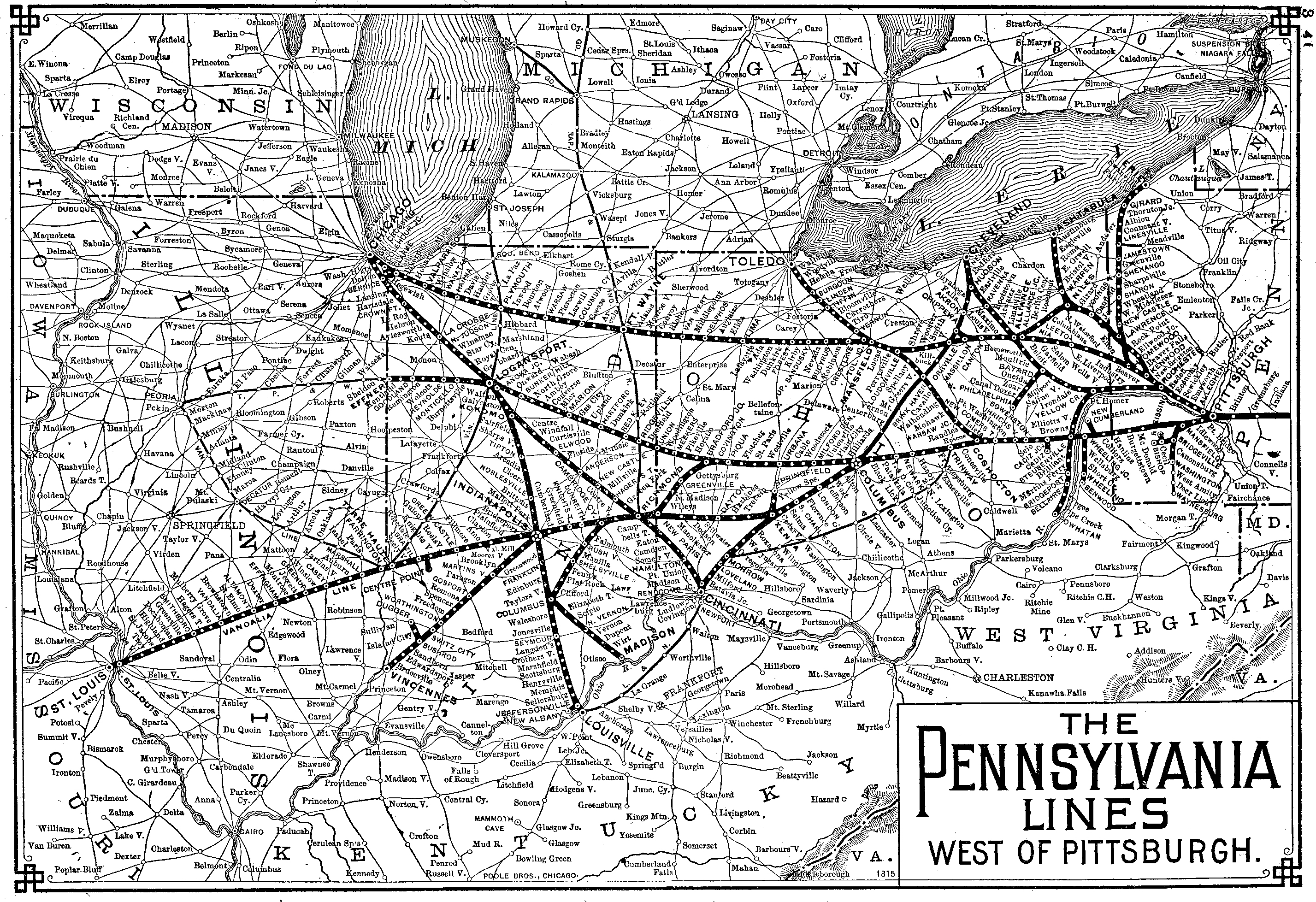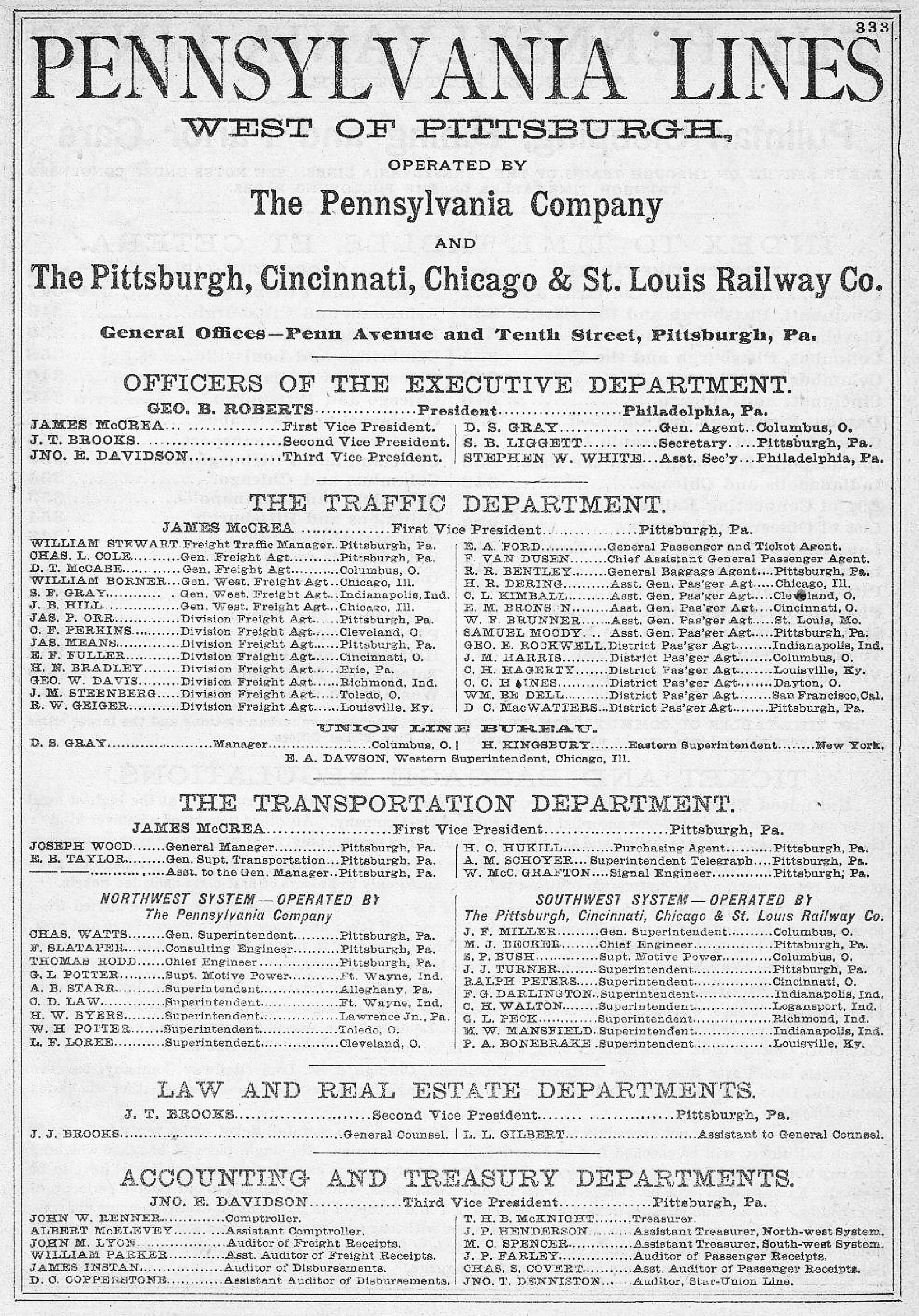Pittsburgh, Cincinnati, Chicago and St. Louis Railroad: "The Panhandle Route"
Last revised: August 23, 2024
By: Adam Burns
The Pittsburgh, Cincinnati, Chicago, and St. Louis Railroad (PCC&StL), more commonly known as the Panhandle Route, was a major component of the Pennsylvania Railroad, comprising most of its network west of Pittsburgh.
The PCC&StL's history is delicately woven into the nation's rich tapestry of transport-related advancement, resulting as a pinnacle of 19th-century railroad development. The birth of the PCC&StL can be traced back to four distinct predecessor railroads.
These included the Pittsburgh, Cincinnati and St. Louis Railway (PC&StL), the Chicago, St. Louis and Pittsburgh Railroad (CSL&P), the Pittsburgh, Chicago and St. Louis Railroad (PC&StL), and the Pittsburgh, Columbus, Cincinnati and St. Louis Railway (PCC&StL), all of which were consolidated to form the PCC&StL.
Photos
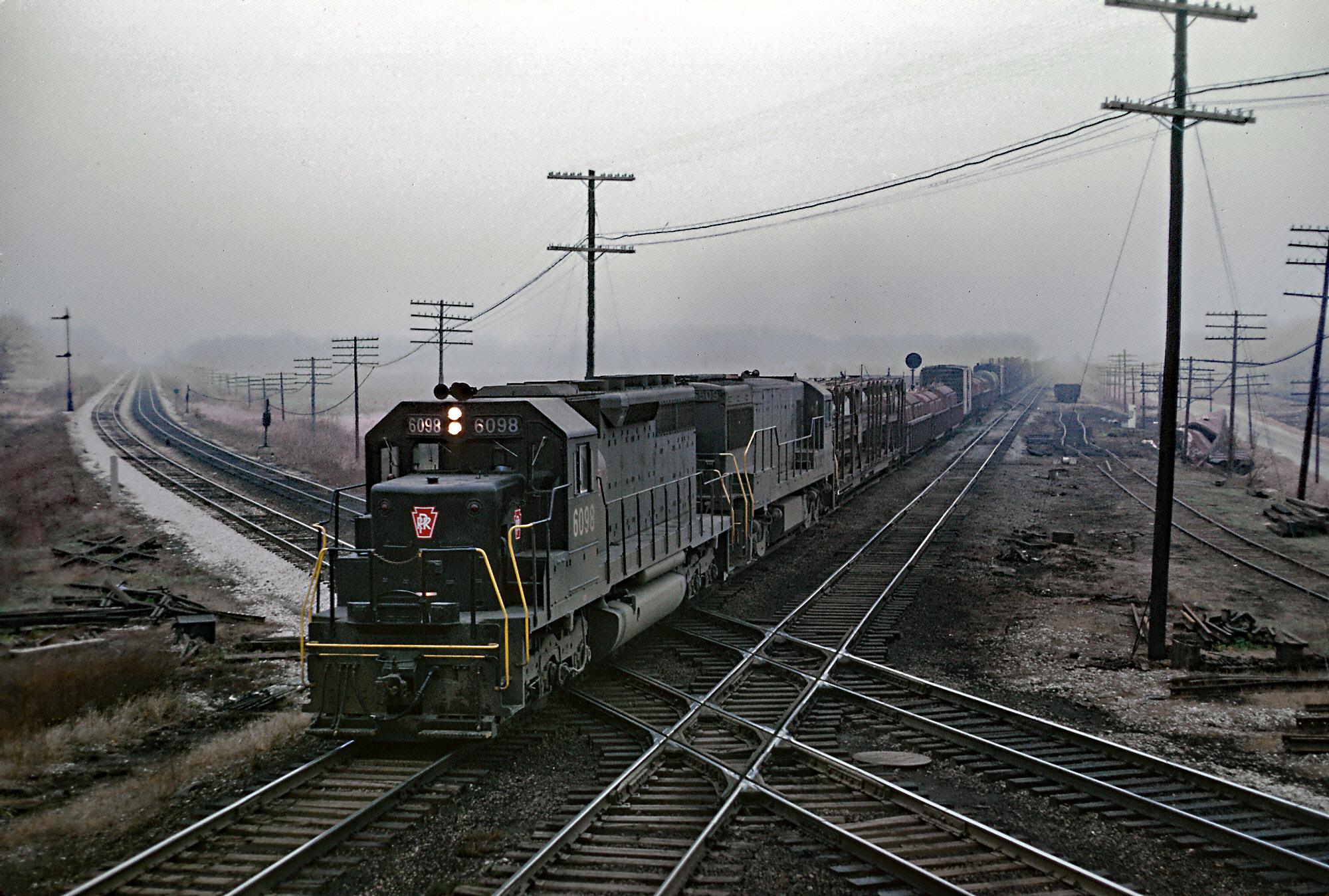 If you are familiar with railroads then the name North Judson, Indiana likely brings a touch a nostalgia. Historically, it was a major junction point of four main lines belonging to the Pennsylvania, Erie/Erie-Lackawanna, Chesapeake & Ohio, and New York Central. Today, all are gone. Here, Pennsylvania SD40 #6098 rattles across the Erie Lackawanna diamond with a manifest freight on November 25, 1966. Roger Puta photo.
If you are familiar with railroads then the name North Judson, Indiana likely brings a touch a nostalgia. Historically, it was a major junction point of four main lines belonging to the Pennsylvania, Erie/Erie-Lackawanna, Chesapeake & Ohio, and New York Central. Today, all are gone. Here, Pennsylvania SD40 #6098 rattles across the Erie Lackawanna diamond with a manifest freight on November 25, 1966. Roger Puta photo.History
In their book, "Pennsylvania Railroad," authors Mike Schafer and Brian Solomon note the PCC&StL's earliest predecessor was the Pittsburgh & Steubenville (P&S). Funded by the PRR this railroad began construction in 1856 to link Pittsburgh with Steubenville, Ohio running via then-Virginia's northwestern panhandle.
The P&S would then link up with the Steubenville & Indiana (S&I) at the latter location, another railroad in which the PRR held considerable stock since 1854.
Unfortunately, the PRR's plan to link Columbus and Cincinnati with Pittsburgh and thereby pull a great deal of freight and passenger traffic away from rival Baltimore & Ohio was jeopardized by the S&I's 1864 bankruptcy.
Following a battle with Virginia to allow the P&S to build across its panhandle, and subsequent act of Congress to force the state's hand, the PRR's so-called Steubenville Extension was completed in 1865, and opened through service to Columbus.
The crucial component of this line was the Hollidays Cove Railroad, which completed a bridge over the Ohio River across the Virginia panhandle to the Pennsylvania state line.
In January, 1868, the Panhandle Railway Company was formed to operate all of these systems, which by then were in financial difficulty. To secure its hold on this property the PRR formed the Pittsburgh, Cincinnati & St. Louis Railway to acquire the Panhandle.
Interestingly, despite the PRR later acquiring the previously mentioned entities to reach Chicago, St. Louis, Indianapolis and other points, all of the lines west of Pittsburgh collectively became known as the "Panhandle Route."
In the pivotal year of 1890, the predecessor entities were consolidated to form the Pittsburgh, Cincinnati, Chicago, and St. Louis Railroad.
At A Glance
Pittsburgh - Columbus - Indianapolis - St. Louis Columbus - Logansport, Indiana - Chicago Columbus - Cincinnati Cincinnati - Logansport Indianapolis - Vincennes Louisville - Indianapolis - Logansport - Chicago Pittsburgh - Fort Wayne - Chicago Mansfield - Toledo Pittsburgh - Alliance - Cleveland | |
Each previous component had established their individual routes and achieved prominence in their respective operational areas; their combined strength propelled the new conglomerate into a strong competitor in the railroad industry.
At its peak size the Panhandle Route primarily served the states of Illinois, Indiana, Ohio, and Pennsylvania.
Its extensive and well-positioned network facilitated efficient connections between some of the crucial industrial and economic hubs of that era, including Cincinnati, Chicago, Pittsburgh, and St. Louis.
At its peak, the PCC&StL commanded a significant geographic footprint. The total length of its rail lines exceeded 2,700 miles, reflective of its strategic network that spanned multiple states and catered to a wide range of passenger and freight transportation needs.
In the year 1916, a transformative event occurred in the history of the Pittsburgh Cincinnati Chicago and St. Louis Railroad.
Pennsylvania Railroad
It was acquired by the Pennsylvania Railroad (PRR), a dominant powerhouse within the industry at the time. This integration ushered in a new phase for the PCC&StL and expanded the breadth and reach of the Pennsylvania Railroad.
The acquisition by the Pennsylvania Railroad, often referred to as the "Pennsy," marked the Pittsburgh Cincinnati Chicago and St. Louis Railroad's transition from being an independent entity into becoming a part of one of the most extensive railway networks in the nation.
The combined network not only augmented the PRR's operational expanse, but it also leveraged the strategic positioning and connectivity of the PCC&StL's tracks.
With the discontinuation of the Pennsylvania Railroad in 1968, and its subsequent merger into the Penn Central system and later Amtrak and Conrail, many segments of the original PCC&StL route were abandoned or repurposed over the ensuing decades. Nonetheless, key stretches of the original route remain in operation today, testifying to its legacy and enduring utility.
Presently, much of the original Panhandle Route remains active under the supervision of different railroad organizations. A significant portion of it in Pennsylvania, Ohio, and Indiana is managed by Norfolk Southern Railway, while segments in Illinois are controlled by the CSX Transportation.
A portion of the track within the city limits of Pittsburgh, however, has been removed. Today, the Panhandle Trail, a recreational path for cyclists and pedestrians, follows the former railroad's right-of-way in this area, illustrating a transformative adaptation of the historical transport infrastructure.
The legacy of the Pittsburgh, Cincinnati, Chicago, and St. Louis resonates strongly within American industrial and transportation history.
The tracks and routes established by this connection became an essential part of the burgeoning economic growth and industrial progress the nation experienced during the late 19th and early 20th centuries.
The PCC&StL's operational impact was multifaceted, enabling the transportation of commodities and people alike. It served as a vital conduit for goods ranging from manufactured items to raw materials, while it also catered to the needs of a growing population of travelers and migrants seeking new opportunities across the nation.
During its heyday, the Panhandle Route epitomized many elements of American industrial enthusiasm and ambition. Its construction involved significant engineering challenges, and its operation was characterized by a strong commitment to service, efficiency, and connectivity.
The successful operation of the Pittsburgh, Cincinnati, Chicago and St. Louis, and the robustness of its rail network, played a catalytic role in catalyzing growth across the region. The railroad's presence facilitated the establishment and evolution of businesses, towns, and cities along its rail lines.
A perfect example of this is the city of Columbus, Ohio. The city thrived as a result of its strategic location on the railroad's main line, and today, it stands as a testament to the transformative impact that railroads can have on the development of urban spaces.
The Panhandle's influence extended beyond the immediate vicinity of its rail lines. Its operations facilitated trade and commerce far beyond the stations it served, enabling the movement of goods and people across the country and contributing to the broader economic dynamism of the late 19th and early 20th centuries.
The movement of coal, steel, and other industrial commodities on PCC&StL trains contributed significantly to the growth of manufacturing in Pittsburgh, Chicago, and other industrial cities. As a result, the railroad indirectly played an influential role in shaping America's industrial landscape.
The passenger services of the PCC&StL were equally impactful, ferrying thousands of people across its territories daily. From leisure travelers to economic migrants seeking new opportunities, the railroad catered to diverse demographics, facilitating societal mobility and cultural exchange.
Many of PRR's famous named trains of the "Blue Ribbon Fleet" operated over the Panhandle including names like the Penn Texas, Spirit of St. Louis, Cincinnati Limited, Jeffersonian, and Liberty Limited.
System Map (1893)
As the years rolled by, the Panhandle Route embraced advancements in rail technology and transport management. As the PRR acquired increasing numbers of diesels, traditional steam was replaced throughout the 1940s and 1950s.
This move generally reflected the railroad's commitment to constant improvement and progress.
Another symbol of technological progression was the introduction of advanced signaling and communication systems. By incorporating new techniques and technologies, the Panhandle was able to enhance the safety and efficiency of its operations, highlighting the ongoing process of evolution within the railroad industry.
Postwar Era
By the post-World War II era the PRR's St. Louis/Cincinnati main line, and secondary route to Chicago via Columbus and Logansport, were well-maintained, double-tracked routes.
The story of the Pittsburgh, Cincinnati, Chicago, and St. Louis is not only one of technical advancement, economic growth, and societal mobility.
It is equally a narrative of resilience and adaptation in the face of significant transitions and challenges that marked the spectrum of America's railroad history.
One such challenge, common to many railroads of the time, was the transition from steam power to diesel. While this technological shift enhanced efficiency and reduced operational costs, it necessitated a complete overhaul of the railroad's operational practices and infrastructure.
Despite such hurdles, the PCC&StL rose to the challenge, investing in new locomotives, overhauling maintenance facilities, and retraining staff to adapt to the new machinery.
This resilience in the face of change ensured the continued relevance and operation of the railroad well into the 20th century.
The consolidation of the Panhandle into the Pennsylvania Railroad's network posed another significant challenge. As PRR began to consolidate its control over the PCC&StL's operations following the 1916 acquisition, the railroad had to adapt once again to a new management style and operational focus.
However, the PCC&StL utilized this change as an opportunity to expand its operational scope, leveraging PRR’s expansive reach to connect more people and places.
The consolidation also led to substantial investment in the PCC&StL’s tracks and facilities, contributing to the line's longevity and operational sustainability.
The transition period following the fall of the Pennsylvania Railroad and the rise of Penn Central, Conrail, and Amtrak opened up yet another chapter of adaptation for the PCC&StL.
This period underlined the railroad's inherent capacity for resilience as portions of its routes continued to operate under new management, despite the extensive reorganization of the rail industry.
Modern routes of the PCC&StL have diversified in usage, reflecting the changing dynamics of the transportation industry. Some sections continue to be used for freight transport, while other segments have been adapted for different uses, including intercity passenger services, metropolitan transit operations, and recreational trails.
As segments of the PCC&StL's original route continue to function today under the operational scope of Norfolk Southern and CSX Transportation, the enduring legacy of the Panhandle Route remains relevant. The freight transported along these lines serves as economic lifelines for industries and communities spread across multiple states.
In its present context, the legacy of the Pittsburgh Cincinnati Chicago and St. Louis Railroad serves not merely as a relic of a bygone era. Rather, it is an enduring reminder of the transformative role that transportation infrastructure can play in catalyzing economic growth and societal advancement.
The social impact of the Pittsburgh, Cincinnati, Chicago and St. Louis was also profoundly felt. Through the movement of people across its network, the railroad aided in the dissemination of ideas, cultures, and lifestyles, indirectly contributing to the societal transformation of the Midwest and Northeast.
The Panhandle Route's story is not merely a tale from the annals of US railroad history. It serves as a living testament to human persistence, ingenuity, and ambition, underscoring the power of transport infrastructure in shaping the course of economic and societal evolution.
As one ventures into the narrative of the PCC&StL, one can appreciate the depth of resilience that this railroad organization embodies. Throughout the countless trials and tribulations, technological upheavals, and transitions in ownership and management, the Panhandle Route has endured and adapted.
The significant mileage of the original PCC&StL route, the multitude of communities it served, and the range of commodities it transported resonate as proud markers of its influence and reach. The assimilation of the PCC&StL into the Pennsylvania Railroad and its later reincarnations further amplifies the railroad’s enduring significance.
Conclusion
Today, Panhandle continues to resonate in the form of its surviving track segments, the goods transported along them, and the adventurous tales that pepper its storied past.
Whether it is the rhythmic clatter of contemporary freight trains or the serene tranquility of converted trails, each serves as a living memory of the Panhandle Route's rich legacy.
We appreciate the foresight of the railroad's early pioneers who recognized the transformative potential of a rail network that could efficiently link Pittsburgh, Cincinnati, Chicago, and St. Louis.
We admire the endurance of the countless workers who laid the tracks and operated the trains, contributing to the railroad's operational success.
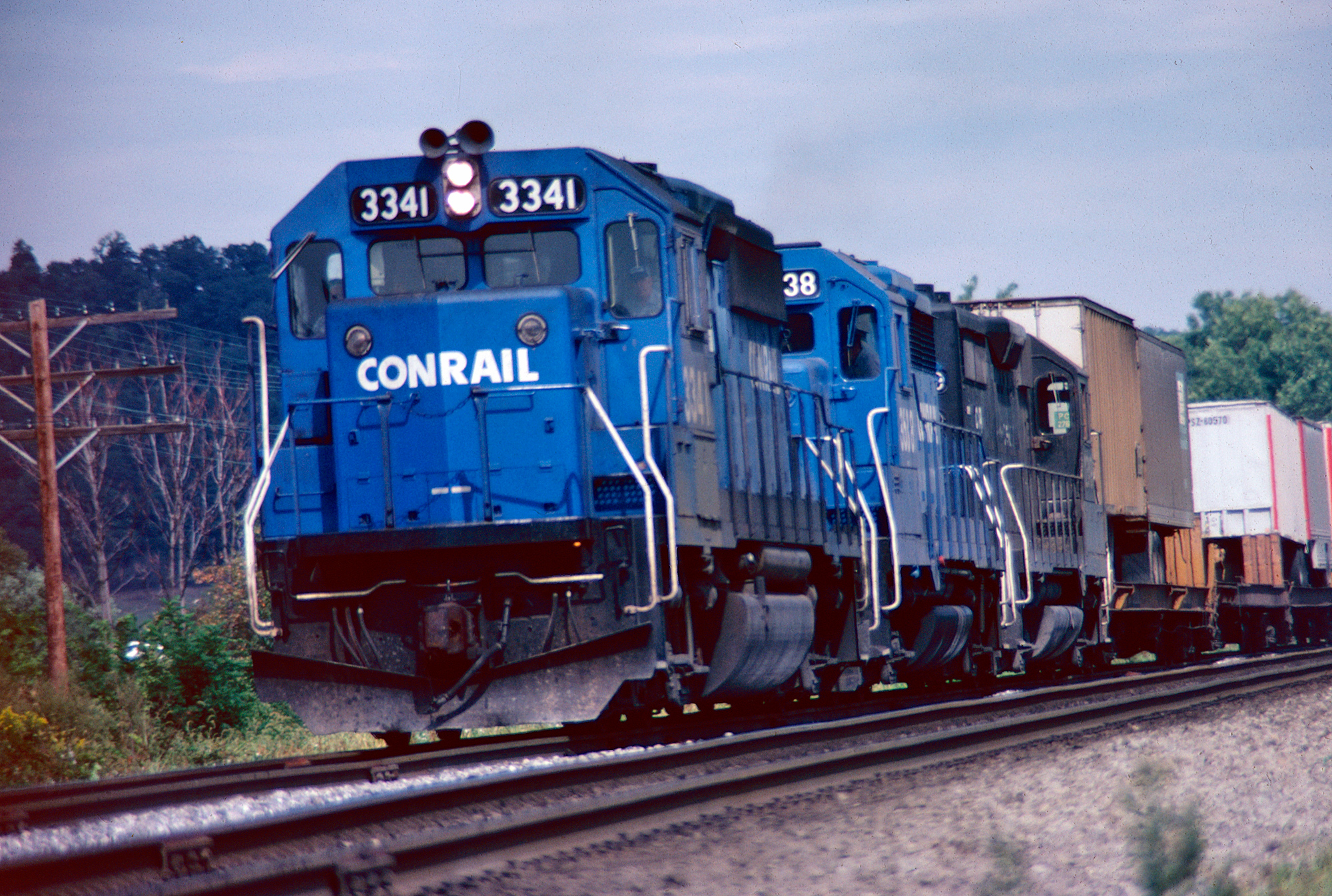 Conrail GP40-2 #3341 hustles train TV-3m along the Panhandle near Port Washington, Ohio on September 28, 1980. Roger Beighley photo. American-Rails.com collection.
Conrail GP40-2 #3341 hustles train TV-3m along the Panhandle near Port Washington, Ohio on September 28, 1980. Roger Beighley photo. American-Rails.com collection.As we delve into these narratives and introspections, we recognize the enduring potency of a seemingly forgotten railroad in America's industrial landscape.
The tale of the Pittsburgh, Cincinnati, Chicago, and St. Louis serves as a potent reminder of the powerful impact that industry and infrastructure can have on shaping the course of societal progress.
This railroad, through the process of its creation, operation, and evolution, underscored the potential of human ambition and resilience.
The legacy of the Pittsburgh Cincinnati Chicago and St. Louis Railroad remains imprinted within America's industrial psyche.
Even as it recedes into the annals of history, its influence on transport, commerce, and society persists, a compelling testament to the railroad's transformative era.
Transport enthusiasts and scholars continue to delve into the intriguing narrative of the Pittsburgh Cincinnati Chicago and St. Louis Railroad.
They weave together the railroad's chronicles, from its formative years, its heyday of operational prowess, its transformations with changing technological paradigms, to its integration into the expansive Pennsylvania Railroad.
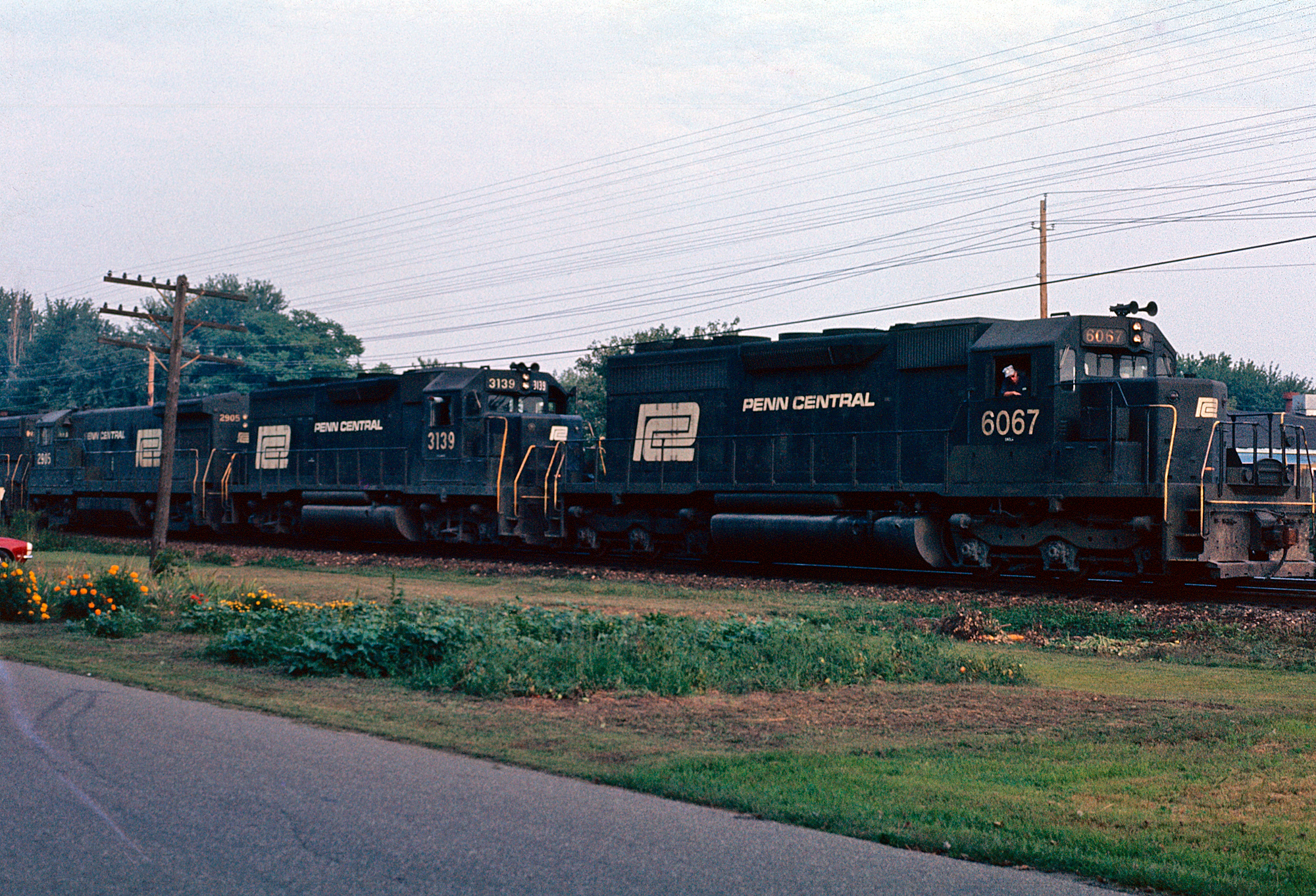 Penn Central SD40 #6067 leads a westbound freight on the Panhandle at Newcomerstown, Ohio; September, 1974. American-Rails.com collection.
Penn Central SD40 #6067 leads a westbound freight on the Panhandle at Newcomerstown, Ohio; September, 1974. American-Rails.com collection.Thus, as the echoes of the Panhandle Route resonate, they solidify an enduring testimony to America's industrial history.
From stirring tales of innovation and determination to lessons of resilience and adaptation, each segment of the PCC&StL's story weaves into our tapestry, reflecting our ceaseless drive for progress.
At each step in its journey, the Pittsburgh Cincinnati Chicago and St. Louis Railroad’s story enriches the lore of American railroad history.
The railroad’s narrative, embedded with achievements, challenges, and transformations, is an emblem of the country’s industrial might and resilience. In acknowledging its past, we pave the path for our collective future.
Sources
- Schafer, Mike. Classic American Railroads. Osceola: MBI Publishing, 1996.
- Schafer, Mike and Solomon, Brian. Pennsylvania Railroad. Osceola: MBI Publishing, 1997.
- Schwieterman, Joseph P. When The Railroad Leaves Town: Eastern United States. Kirksville: Truman State University Press, 2001.
Recent Articles
-
North Carolina's 'Wine Tasting' Train Rides
Dec 14, 25 07:31 PM
A noteworthy way to explore North Carolina's beauty is by hopping aboard the Great Smoky Mountains Railroad and sipping fine wine! -
Nevada's 'Wine Tasting' Train Rides
Dec 14, 25 07:20 PM
While it may not be the first place that comes to mind when you think of wine, you can sip this delight by train in Nevada at the Nevada Northern Railway. -
Nevada - Murder Mystery - Dinner Train Rides
Dec 14, 25 12:40 PM
Seamlessly blending the romance of train travel with the allure of a theatrical whodunit, these excursions promise suspense, delight, and an unforgettable journey through Nevada’s heart.

